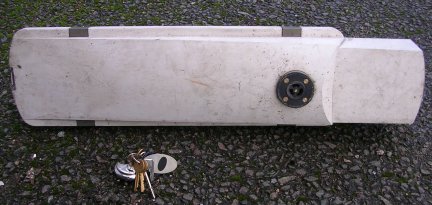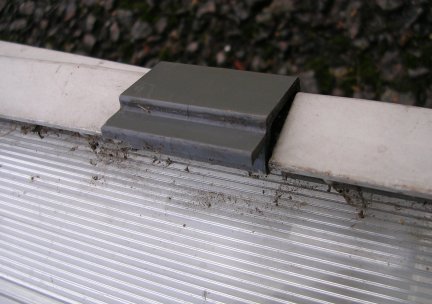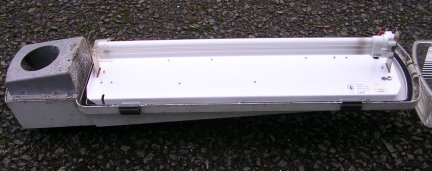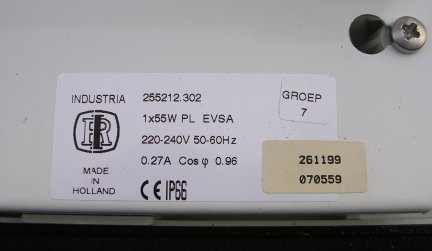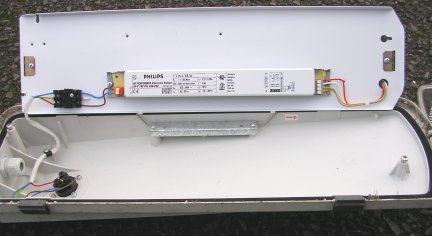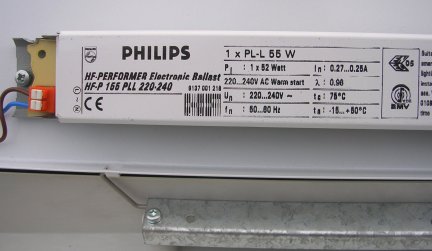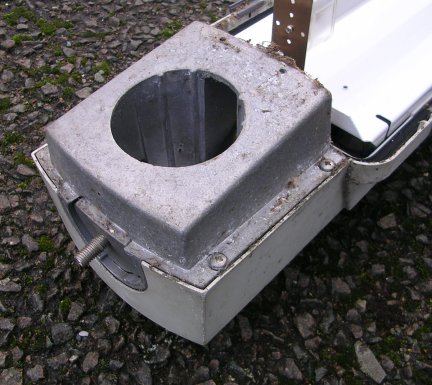WRTL/Industria 'Iris' IRIS55FHF
55w CFL-L Fluorescent lantern
|
WRTL/Industria
'Iris' 55w fluorescent lantern.
Moulded from GRP with a UV-stabilised polycarbonate bowl, the Industria 'Iris'
lantern is a very robust, but versatile lantern that comes in three sizes
and lends itself to use with either compact fluorescent lamps up to 60w, or
low- pressure sodium lamps up to 90w. The fitting can be either side-entry
mounted, or post-top mounted by use of the 'trapdoor' fitting at the rear of
the lantern; a feature incorporated in other modern WRTL/Industria lanterns
such as the Vectra. The Iris also has a very high ingress protection
rating of IP66, which should ensure a long working life. WRTL/Industria have
designed the lris for use on side roads, footpaths and in
residential schemes. In the Midlands the lantern did begin to see some
use in Staffordshire as a CFL lantern to replace obsolete and less efficient
mercury lighting, but was phased out by the contractors in favour of the
Industria 2500 'Lamda' CFL lantern. The Iris has also found favour with
Nottinghamshire County Council, as a 90w SOX lantern for had-hoc replacements
of older 90w SOX lanterns in the County.
And can be ordered for use with the following lamp types:
The Iris in the collection is the largest version available at 800mm long and is a 55w compact-fluorescent lantern. The fitting had been used at an unknown location in Staffordshire until a couple of years ago, however, the lantern had been returned to the depot after the column it was on had to be taken down. The lantern had then been left in the stores and forgotten about until it was discovered during a recent clearout in 2006. By that time, the contractors where using the Industria 2500 as their standard CFL lantern, so the lantern was surplus to requirements and was subsequently acquired for the collection.
The wedge shaped profile of the Iris is not too disimilar to that of the WRTL/Industria 2500 'Lamda' lantern, but unlike the 'Lamda', the bowl has refractors moulded into it and is a lot deeper because it is also used in the SOX lamped versions of the Iris, which carry the larger diameter SOX lamps.
The lantern in plan view showing the canopy top and the position of the NEMA socket. The disc lock and keys have been placed by the lantern to give a sense of scale.
A three quarter view, showing the clean lines of this modern fitting.
By undoing the four plastic bowl retaining clips at the sides of the canopy, the bowl can released and opened on its forward mounted hinge. The shortest model only has two bowl retaining clips.
With the bowl opened, accesss can be gained to the lamp and to the two gear tray retaining screws.
The Iris has an excellent ingress protection rating of IP66. The posi-drive screw to the right is one of two retaining screws that hold the gear tray into position. When these are loosened, the gear tray can be slid forward and then lifted to gain access to the control gear beneath (see below).
Philips PL-L 840/4P 55w compact fluorescent lamp for use in the Iris 55w PL lantern.
By undoing the two retaining screws and siding the gear tray free of them, the tray can be hinged open to reveal the Philips HF Performer electronic ballast and terminal block connectors.
Some of the data printed onto the the Philips HF-Performer 55w ballast
The excellent bowl seal and the plastic gland nut that fits around the incoming feed cable, combine to prevent particle and water ingress. The integrity of these seals is proven by the immaculately clean interior of the lris.
The hinged 'trapdoor' feature of the lantern enables either side-entry mounting, or post-top mounting. An example of the shorter 36w PL-L version of the Industria 'Iris' fluorescent lantern seen in Great Wyrley, near Cannock, Staffordshire in 2006, where it was used to replace obsolete mercury lighting. Note that a spacer has had to be used on the old bracket because it is of too smaller diameter for the wide opening of the Iris's spigot mounting receptor.
Post-top mounted 55w PL-L variant of the IRIS seen in a side road on a residential development in Featherstone, Staffordshire on the last day of 2006. For more information on the Iris lantern visit: http://www.wrtl.co.uk/html/cat-products/-1--road-iris-ip66-2-30.htm |
||||||||||||||||||||||||||||||||||||||||||||||||||||||||||||||||||||||||||
Copyright(c) 2005 Claire Pendrous. All rights reserved.
Please note that all pictures are by Claire Pendrous, or are part of the Claire Pendrous photographic collection unless otherwise stated; none of these images can be copied without obtaining prior permission.

